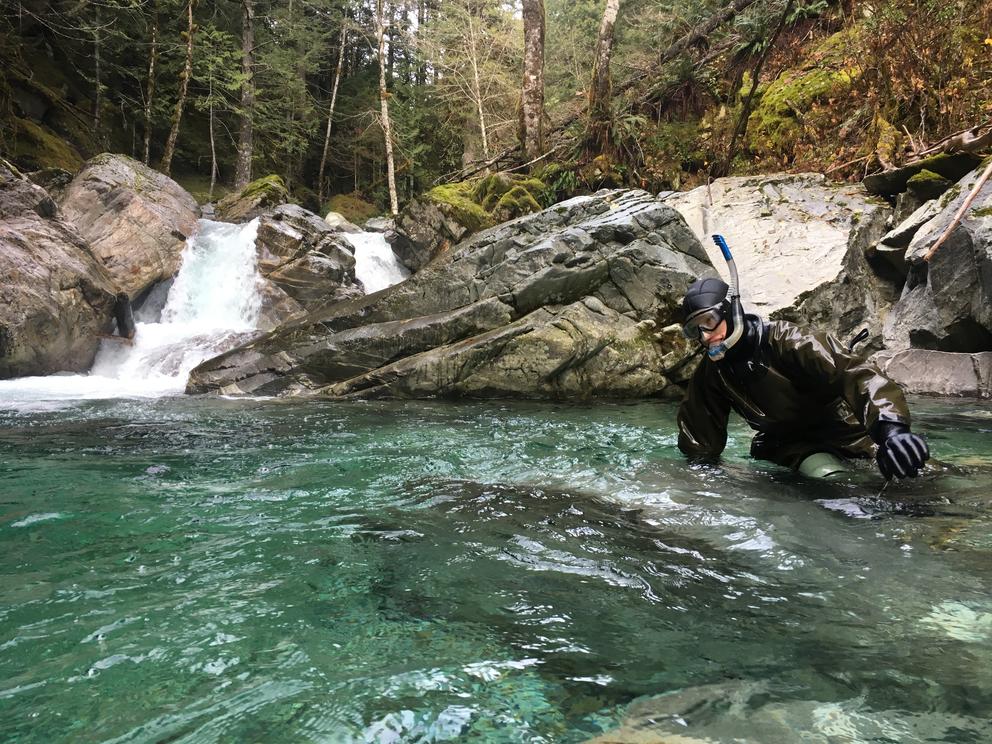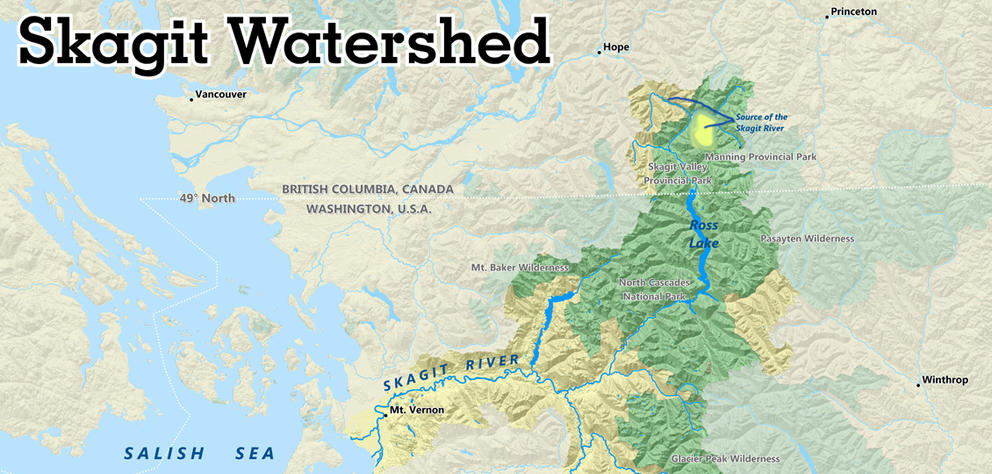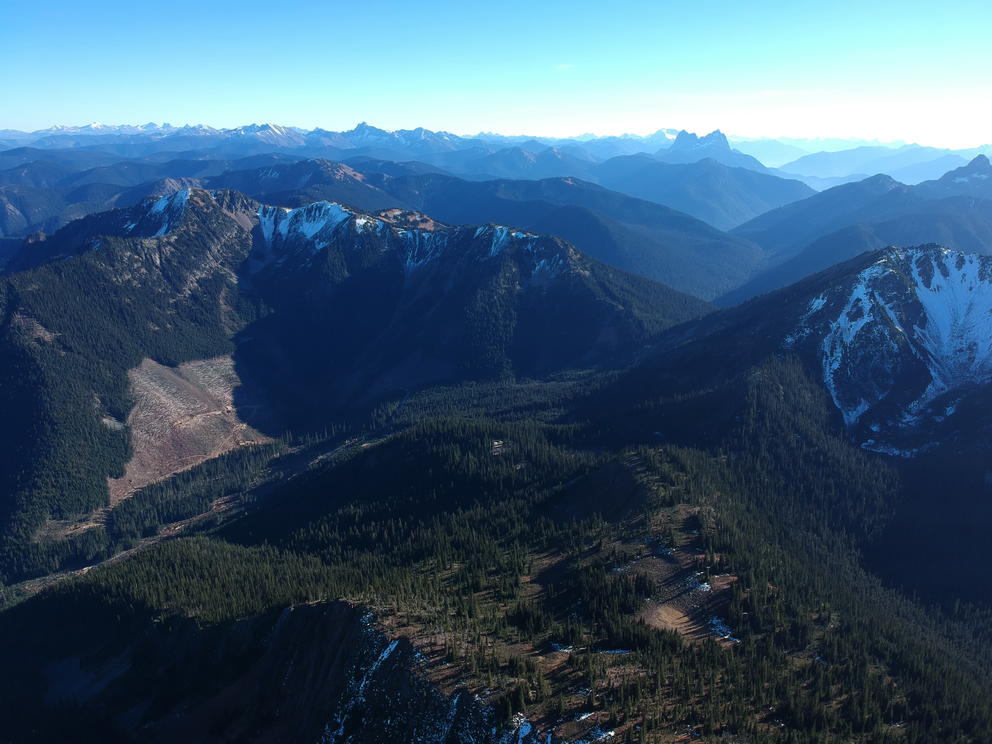“I like to call bull trout the polar bear of the North Cascades,” says Ashley Rawhouser, an aquatic ecologist at North Cascades National Park. “We’re concerned about the bull trout in the upper part of the watershed. We’ve seen their numbers go up and down over the years, and they’re currently on a downward trend.”
Bull trout are extremely sensitive to habitat changes, and as such serve as a bellwether for the overall health of an ecosystem. But for Washington's North Cascades monumental changes loom just 30 miles upriver, across the border in the mountains of British Columbia, where a proposed open-pit gold and copper mine could be dug into the headwaters of the Skagit River watershed.
With conflict brewing between the international neighbors over jobs and fish, Gov. Jay Inslee and all nine members of Washington’s congressional delegation denounced the mine in May and called for the U.S. State Department to stop it. It’s a cross-border tangle that’s of grave concern to tribes south of the 49th parallel who have a deep connection to the Skagit River. If the project is approved by the British Columbia government, a 14,000-acre parcel of wild, unprotected country known as the “doughnut hole” nestled between Manning and Skagit Valley Provincial Parks could become the site for up to five years of mining.
The saga began in 2018, when Vancouver-based Imperial Metals applied for a permit to begin exploratory drilling near the headwaters of the Skagit River. In response, a coalition of environmental organizations, state and city governments, and Indigenous groups on both sides of the B.C.-Washington border joined forces to oppose logging and mining in the Skagit headwaters because of risks to salmon and trout.
On one front, the opponents have succeeded. In December 2018, the B.C. government announced it would ban logging in the Skagit headwaters, which began in 2015 in part to establish a series of mountain roads that would help crews access mining sites.
But a denial of the mining permit is far from certain. A declining timber industry and growing global demand for metals is putting pressure on B.C.’s provincial government to generate more resource-extraction jobs. And that has biologists and members of Washington tribes, such as the Upper Skagit and Swinomish, worried about the potential for pollution and heavy-metal contamination that could come with the mine.
Tribal fears go beyond losing bull trout: The Skagit River is the largest source of fresh water feeding into the Salish Sea, and the only river on Puget Sound that’s home to all five species of native salmon: pink, chum, sockeye, silver and chinook. Those runs have been in a steady decline, says Scott Schuyler, chairman of the Upper Skagit Tribe.
“We’ve seen one fall chinook run in 20 years,” Schuyler says, “and only one spring chinook run in the past 50. I have two children and one granddaughter and she’s never seen a wild chum salmon. We aren’t able to pass on our culture, because there’s no salmon.”
Shared rivers
The Skagit River’s 150-mile-long watershed begins at Allison Pass high in B.C.’s Cascades, and for decades Washington and British Columbia have quarreled over it. A series of dams were built on Washington’s portion of the river in the 1920s and ’30s — including Ross Dam, which, with the other dams on the river, supplies about 20% of Seattle City Light’s power, and which created a 24-mile namesake lake that extends into British Columbia.
In 1984, City Light signed a treaty agreeing not to build a higher dam in return for assurances from B.C. that it would keep the river free from pollution. The cross-border Skagit Environmental Endowment Commission was created that same year to resolve future disputes.
In mid-2018, Seattle Mayor Jenny Durkan wrote a scathing letter to British Columbia Premier John Horgan and the commission on behalf of City Light, taking issue with plans to log and mine the headwaters. The projects, she said, would threaten the city’s $77 million conservation efforts to recover threatened chinook salmon. The Skagit accounts for about 80% of chinook in Puget Sound — the preferred food of the region’s embattled orcas.
“The Skagit is the last best hope for chinook salmon in Puget Sound,” says Rawhouser, the North Cascades National Park aquatic ecologist.
A more recent letter from City Light in May 2019 took issue with the exploratory mining project, citing inadequate environmental protections in the plan. “The collecting pond they have for the wastewater is way too small, and our estimate is it’ll fill up in about 10 minutes,” says Lynn Best, chief environmental officer of City Light.
And Imperial Metals’ record of environmental safety has opponents worried: In 2014, an earthen dam holding back a tailing pond at Imperial Metals’ Mount Polley mine in south central British Columbia collapsed, sending 24 million cubic meters of wastewater laden with arsenic, lead, selenium and copper into Quesnel Lake. It was one of Canada’s worst environmental disasters, and may have had a disastrous impact on one of B.C.’s most robust sockeye salmon runs. Who will pay for restoration and cleanup remains in dispute.
Officials with the British Columbia Ministry of Energy, Mines and Petroleum Resources denied a request for an interview but said in an email statement that statutory decision makers — a group of nonpolitical technical staff in the ministry — are still reviewing the mining proposal.
“Statutory decision makers have a responsibility to complete a thorough and comprehensive review, and to consider all relevant information and perspectives,” the statement said, “including feedback received from First Nations, environmental organizations and the public.”
The Skagit is just one of many rivers in Washington threatened by B.C.’s enthusiasm for mining, says Mitch Friedman, executive director of Conservation Northwest. By his organization’s count, there are 33 active or proposed mines within 60 miles of B.C’s southern border. He cites the Copper Mountain Mine situated above the Similkameen River, which flows into central Washington’s Okanogan River. “The tailings pond there is three times the size of the one that blew out at Mount Polley,” says Friedman. “And it’s an earthen dam. It’s terrifying, this thing just sitting there. It’s a time bomb.”
Conservation Northwest has called for reforms to British Columbia’s mining regulations — especially provisions that require mining companies to prove they can cover the costs of a catastrophic spill. The current system doesn’t require restoration of damaged watersheds and allows companies to avoid cleanup costs by declaring bankruptcy.
According to Holly Tally, a spokesperson for the B.C. Ministry of Energy, Mines and Petroleum Resources, a new financial assurance policy is under development, but the ministry wouldn’t make details of the new rules public until the process is finished.
Indigenous groups join in opposition
Brian Cladoosby is chairman of the Swinomish Tribe, whose reservation is in the flat, wide floodplains of the Skagit River delta. The Swinomish have been fishing for salmon in the Skagit and Puget Sound for thousands of years.
“We’re known as the salmon people,” Cladoosby says. “We put away up to 40,000 pounds of salmon that we purchase or catch. And we freeze that salmon and we eat it throughout the year, whether it's funerals, weddings, or birthdays. It’s our greatest natural resource.”
Since he began fishing in the 1970s, Cladoosby has seen runs decline precipitously. “In 1975, we would start the third week of June,” he says. “And we’d basically fish continually right through until the end of December with only a few weeks off in between the runs. We’d have the king salmon, then we’d have the pink salmon, then we’d have the silver salmon, then we’d have the chum salmon, then the steelhead.”
Today, things are different. “Now we'll start in June to fish on the hatchery kings,” Cladoosby says, “and we'll probably fish about two or three weeks for that. Then we’ll fish in July for two or three weeks with sockeye. And if the silver runs — and they haven't been that good in the last few years — we’ll start in September and fish through September and then we’re done for the year.”
Both the Swinomish and the Upper Skagit are involved in a cross-border annual summit of 66 Indigenous groups called the Coast Salish Gathering, which also includes First Nations from coastal British Columbia and other tribes in Western Washington.
“Headwaters are special,” says Schuyler, chairman of the Upper Skagit Tribe. “That’s where it all begins. You have a duty to think about what you do, and the effects it has on what’s downstream.”
Schuyler notes that even though the Washington tribes don’t have standing with the B.C. government, they’ve consulted with B.C. First Nations in order to make sure their concerns are heard. “We were pleased to see that logging was banned in the headwaters, and we hope that translates into the same sort of protections from mining,” Cladoosby says. “We need fresh, clean cold water for the salmon.”
A sensitive fish
Bull trout are a finicky fish: They require extremely cold, pristine water and complex river habitat with plenty of riffles, pools and shade provided by fallen logs. Though they don’t return to the sea like salmon, they have migratory patterns within the river.
According to Rawhouser, there are generally two types of bull trout on the Skagit. The first are those that spend most of their lives in the human-created lake behind Ross Dam. These fish don’t typically get more than 8 inches long. A second, more robust variety known as adfluvial bull trout migrates up into the streams feeding into the Skagit River and Ross Lake and can travel far into British Columbia to spawn. This migrating variety of bull trout grows much larger than their sedentary cousins, reaching lengths of up to 2½ feet.
“The bigger the fish, the more successful they are in spawning,” Rawhouser notes. “They can dig their redds deeper, so they withstand flooding events more. The females have more eggs, so they produce more offspring.”
Even small amounts of sediment clouding these glacier-fed creeks can inhibit bull trout in their fall spawning. A mine, a drilling site, road construction or any activity that generates dust and debris is often enough, says Rawhouser. “This fine sediment can get into the stream channels and it can bury the fish redds,” he says. “It basically seals the eggs in a casket, where they don't get enough oxygen and die.”
The teams of divers he’s been working with have collected data on bull trout in streams located in North Cascades National Park, but information on the fish in British Columbia is lacking. Wildfires in B.C. in 2018 and a large landslide that clouded waters in 2019 prevented studies from occurring in the past two years.
The Skagit headwaters already has a test case for a mine’s effect on fish. Silverdaisy Mountain has a variety of small-scale drilling and mining sites that date from as far back as the 1930s. In 2007 and 2008, the Skagit Environmental Endowment Commission hired environmental contractor Limnotek to determine if these sites were leaking anything toxic into the Skagit basin.
The study found that even these relatively small mining sites were leaching elevated levels of cadmium, lead and zinc into creeks that feed into the Skagit. Cadmium is a particularly potent risk to bull trout, says Rawhouser.
“It affects their osmoregulation, their ability to control the salts in their body,” he says. “So one of the unique things about being a freshwater fish is that you are basically like a big bag of permeable salt, and the salt in your body is always trying to leach out into the fresh water, which has low concentrations of salt.”
If the fish can’t regulate those salts, they get weak and die, Rawhouser says.
Though he and his team have yet to see direct evidence of this sort of poisoning in bull trout, they’ll be working with the U.S. Geological Survey this summer to study river sediments near the U.S.-Canadian border to get more accurate measurements of metals such as cadmium.
If even these small disturbances are already having an impact, the risks from a huge open-pit mine are exponentially higher, notes Swinomish Chairman Cladoosby: “It’s well-documented that this type of mining around the world has left nothing but a scar on the environment,” he says. “The corporations come in, make all their profits, pay all their shareholders, and then they leave and they leave a degraded environment for us to deal with.”
“This mine is just one project,” says Schuyler of the Upper Skagit Tribe. “But it all feels like a death by a thousand cuts. Climate change, habitat degradation, warming water, the loss of chinook and orcas. We’re seeing environmental degradation becoming the norm."




